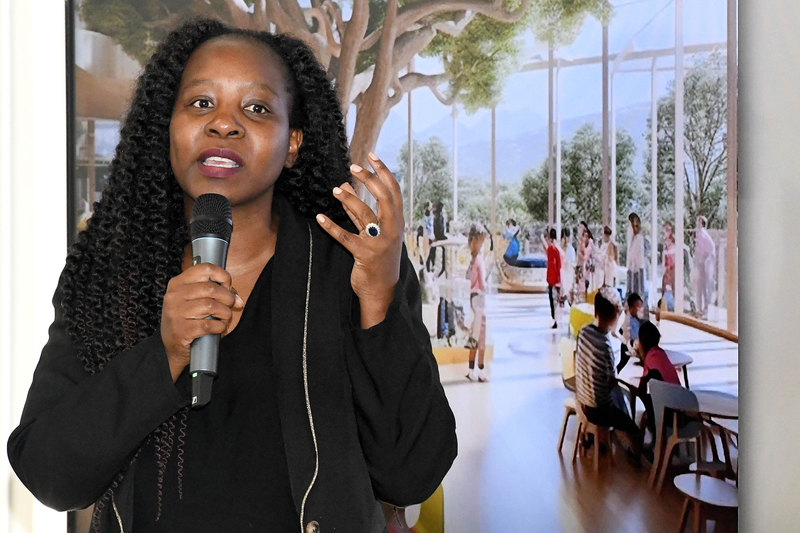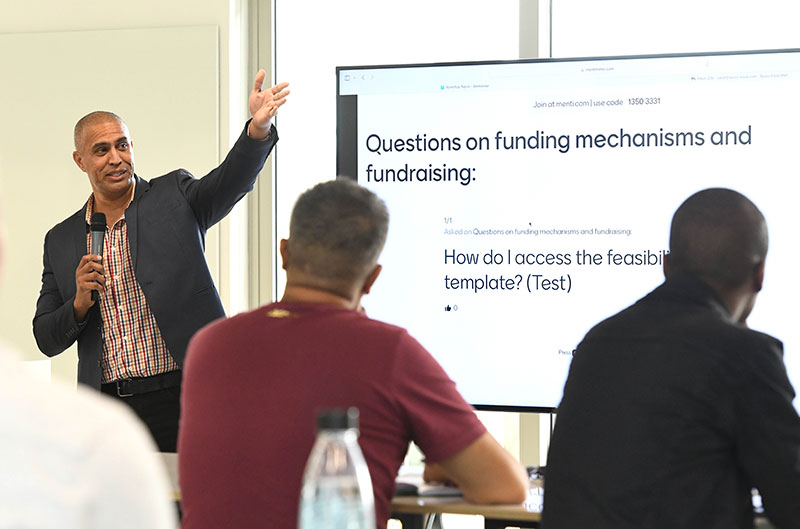UCT’s University of the Future deliberates funding guarantees
22 February 2024 | Story Kamva Somdyala. Photos Nasief Manie. Read time 3 min.
The financial roadmap of the University of Cape Town’s (UCT) University of the Future (UoF) projects was deliberated on during one of several workshop sessions held recently at the Hasso Plattner School of Design Thinking Afrika (d-school Afrika).
A range of speakers took to the podium, including the chair of the UoF’s steering committee, Professor Salome Maswime; and the university’s head of national fundraising, Stafford Bomester.
They were joined by the Entrepreneurship Development in Higher Education (EDHE) national chair for student entrepreneurship, Nadia Waggie; fundraising expert Michelle Stein; and venture capitalist specialist Daniel Steenkamp.
Out of 37 projects, 32 have been accepted into the UoF Challenge. Each must satisfy key questions, namely:
- Is it fit for purpose?
- Is it fit for UCT?
- Is it fit for the future?
- What is its long-term feasibility?
- What is the return on investment?

“The point is to move from idea to a place where projects will start looking feasible. An exhibition will be held to showcase the ideas,” Professor Maswime said.
“It’s about workshopping the ideas in a manner that makes a business case that can attract the necessary funding. There is a commitment to support each idea individually and there will be various milestones along the way to celebrate and support and help develop each idea.”
Persuasiveness
Stein touched on persuasiveness in her presentation: “Always lead with the problem. To be persuasive to someone, you may first need to care about the issue before they [potential investor] can believe your solution is the right one. Take these steps into consideration: answer what the problem is, and what its consequences are and [look for] what is not as well known about the problem. In other words, what haven’t you considered about the problem; share an anecdote, story or data which proves the existence of a problem. Once these are covered, you can move to solution phase.”
She added: “Simplicity is key. To be persuasive, you must speak in very simple language, particularly for a campaign that is looking for a broad range of funders so that whatever background investors come from, they are able to understand what the project is about.”
“Fundraising is not a one-size-fits-all affair.”
Bomester advised exercising patience when engaging in a fundraising effort.
“We exist to help conceptualise a plan that’s going to work for your project by getting an idea of what’s fundable and giving feedback on whether it will be long-term, regional or industry-specific. The strength of your project is directly linked to the strength of your support and personal networks; fundraising is not a one-size-fits-all affair. If you don’t have any networks, there are avenues which one can be supported through to get the necessary support by way of creating events and profiling the project as a start,” he said.

Pitching from a venture capitalist point of view, Steenkamp shared a listicle for attracting a “high-risk, high-reward” investor:
- Have a compelling story.
- Spend time unpacking the need vs the solution of your funding needs.
- Craft a team with a track record.
- Consider what the return on investment will be.
- If possible, invest some of your own money.
In conclusion, Waggie shared the four pillars of the UCT entrepreneurship hub, which fall within the domain of the UoF project: mentorship and networking with staff, alumni, entrepreneurs and industry experts; having a customised curriculum for each stage of the entrepreneurship journey, combined with experimental learning; research and innovation support as well as structured alignment to design thinking.
 This work is licensed under a Creative Commons Attribution-NoDerivatives 4.0 International License.
This work is licensed under a Creative Commons Attribution-NoDerivatives 4.0 International License.
Please view the republishing articles page for more information.










